Robbery suspect arrested
TB25018991 & TB25019362
Police have arrested a suspect accused of robbing the same business twice within the span of a few days.
Thunder Bay Police Service officers had responded to a Simpson Street business on the afternoon of May 15, 2025, after receiving a report of a robbery that had just occurred.
A male suspect with his face covered entered the location, brandished a knife towards an employee, and demanded money. The suspect fled prior to police arrival.
Then, on May 17, police were called to the same location for another robbery. A male suspect, who appeared to have many similarities to the individual involved in the previous incident, entered the location and demanded money from an employee. Again, the suspect fled prior to police arrival.
The BEAR Unit became involved in the investigation.
The investigation led to a suspect being identified. The suspect was located and arrested on Tuesday, June 17.
John Martin RECOLLET, 43, is charged with Robbery x2 and Disguise with Intent.
The accused appeared in court on Wednesday and has been remanded into custody with a future appearance date.


